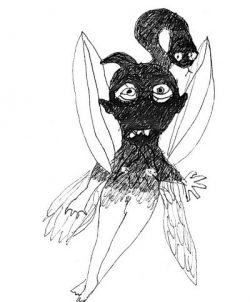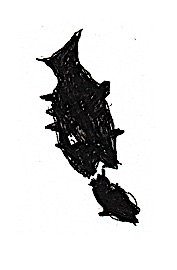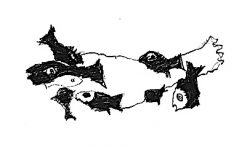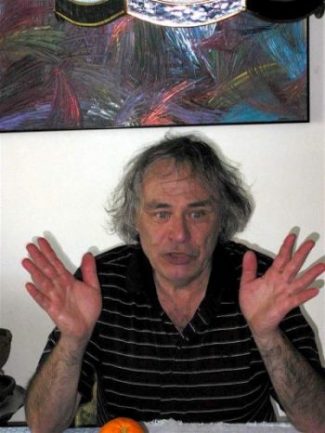#510 Joe’s monsters and critters
March 20th, 2019

Bite Me! Musings on Monsters and Mayhem
by Joe Rosenblatt
Erin, Ontario: Porcupine’s Quill, 2019
$16.95 / 9780889844247
Reviewed by Phyllis Reeve
*
 The day after Joe Rosenblatt died, his last book arrived in pre-publication digital format. I don’t want to write an elegy; others are doing that. It turns out I don’t need to; the poetry itself provides more than enough insight into mortality.
The day after Joe Rosenblatt died, his last book arrived in pre-publication digital format. I don’t want to write an elegy; others are doing that. It turns out I don’t need to; the poetry itself provides more than enough insight into mortality.
Rosenblatt’s writing inhabits a parallel universe that sometimes overlaps with ours enough for a poor benighted reader to catch a glimpse of something weird and wonderful and grotesque and enchanting, definitely rich and strange. His previous book The Bird in the Stillness (2016) took us into the woods near his Vancouver Island home to meet the Green Man, a lyrical merging of author with tree.
His “novel” Snake City (2015) featured a hero, Freddie, whose best friend, a snake named Cottonmouth, hid among the ties hanging from a chrome hanger in a closet and whose companions include an alligator named Handsome Harry, a “snorty” hog, several repulsive nymphomaniacs, and a young man with three eyes, all in conversation with the angel Gabriel.
His final book plunges into offshore depths, sweats its path through tropical rainforests, and soars “above those lingering puffs of smoky acrid clouds,” to bring together the elements — wet, dry, hot and windy — of his whole lyrical “monsterology,” both a culmination and a continuation of all that went before.
Take the title: Bite Me! — a slangy response to a perceived insult and a signal of the poet’s central conceit. Sonnets alternate with prose snippets, and the introductory prose piece, “My Hungry Muse” warns: “I am letting the famished imagination out on a field trip.” His muse is not simply “hungry;” it is “ravenous,” akin to super-snakes and carnivorous plants; it scavenges in the sea around it and in the more exotic scientific reaches of the internet:
What especially fascinates me and excites my ravenous muse is the marine life existing at the bottom of the deepest oceans, bioluminescent critters that appear like ghostly mermaids to mariners gazing through the window of their bathysphere.
Rosenblatt loves old-fashioned slang words like “critter” and “noggin,” especially when he can associate them with “bioluminescent” or “herpetology.” In the first poem, which provides the title, a conger eel (“not a pretty sight”) eats someone’s legs; grizzly comedy accelerating to horrified realisation: “I kept on descending into a malaise of despair/ while each of my arms pleaded ‘Bite me!’/ to an approaching monster who wore my face.” We recognise the monster as carnivore but also as cannibal, and more than cannibal, self-cannibal. Natural history as autobiography.
 Disgusting? Well, yes, but no. The language is so rich, the pace so exhilarating, the images so startling, and the wit so wry that one cannot pause for disgust. This first of the book’s three sections, “Musings on Monsters and Mayhem” explores this bizarre gastronomical theme. In “A Drooling Plant” we are told, “There’s a lot of serious dining going on in heaven,” where “A myriad of stomachs are demanding to be filled” and “either you’re the eater, or the one who’ll be consumed.”
Disgusting? Well, yes, but no. The language is so rich, the pace so exhilarating, the images so startling, and the wit so wry that one cannot pause for disgust. This first of the book’s three sections, “Musings on Monsters and Mayhem” explores this bizarre gastronomical theme. In “A Drooling Plant” we are told, “There’s a lot of serious dining going on in heaven,” where “A myriad of stomachs are demanding to be filled” and “either you’re the eater, or the one who’ll be consumed.”
The imagination is “a bulbous flower that is always in need of nourishment” — “vital grub” which the sonneteer provides in the form of “metaphors, similes, ambiguities, rhyming, half rhyme, even an answer to one of life’s dilemmas, all in the concluding couplet of a sestet.” More than natural history, a sort of Rosenblatian theology evolves: “There are days I view God as some gargantuan plant/ hidden away in the setting of a dense tropical forest. /Or turned inside out, He could possibly be a stomach.”
But God moves away without leaving a forwarding address and never answers the poet’s emails. He might be an octopus or a supernal squid. “Minnows of epistemology nibble in my brain.” Rosenblatt tells us in a prose explication:
 Such is my fascination on how gifted nature is in extraordinary intelligence that I began to visualize that my brain in a potted plant requiring a daily conveyance of fresh invigorating ideas, for without that essential pollination, how could I have brought into being all of the above creations, benign and malevolent?
Such is my fascination on how gifted nature is in extraordinary intelligence that I began to visualize that my brain in a potted plant requiring a daily conveyance of fresh invigorating ideas, for without that essential pollination, how could I have brought into being all of the above creations, benign and malevolent?
How indeed? He has written elsewhere of his Lunatic Muse, but he had another Muse, a sane and beloved one, whose presence is felt throughout this volume. Rosenblatt’s wife Faye, who predeceased him by exactly two years, was a dedicated member of the Qualicum Beach Streamkeepers; a worshipper, he liked to tease, at the Church of the Holy Minnow. One of his more memorable oil paintings enlarges her tiny fingerlings into a “Moby Minnow.”
Faye died, and in the essay “Are Those Your Tears or Mine?” he mourns, “I’m filled with an insurmountable sadness that I can’t waft away.” He becomes obsessed with the drowning puppy in a Goya painting — “its ears turned back and its snout pointing up at a soiled ochre sky.” He learns that Goya never intended the painting for public exhibition: “It would appear that as a result of his deafness, the billowing vapour of melancholia was embodied in his doomed dog which was, in a sense, his alter ego.”

Faye Carol Smith Rosenblatt (1937-2017) stalwart of the Qualicum Beach Streamkeepers. Faye was also a musician and music teacher
Goya’s dog resembles the tragic street dogs of Havana, honoured by Rosenblatt in the little book Dog (2009), which he co-authored with poet Catherine Owen and photographer Karen Moe, and which appeared in Italy as Caneide, translated by Ada Donati.
The Reaper is “harvesting his limitless supply of victims” and, the poet knows, “My dark cloud won’t vacate my noggin any time soon.” What other poet uses the word “noggin” in a treatise on death? But Joe Rosenblatt is not any other poet. A reviewer confronts the lack of other artists, visual or literary, to whom he may be compared. His universe has some affinity with those of Henri Rousseau or Hieronymous Bosch, but we have mentioned Goya; and in the context of Rosenblatt’s gourmand fantasia we cannot ignore that artist’s shocking painting of “Saturn devouring his son.” As for the words, who are his comrades? — Ezra Pound? Mallarme and the Symbolists? What about William Blake?
 The drawings. What of the drawings? Hastily viewed, they might be doodles. But these are Rosenblatt’s doodles, and there is a lot going on. There may be birds, cats, snakes, fish, spirits, angels, plants, all fighting and all making love. The winged apparition in the first drawing has dainty cherubic feet and a monstrous horned head from which a serpent erupts.
The drawings. What of the drawings? Hastily viewed, they might be doodles. But these are Rosenblatt’s doodles, and there is a lot going on. There may be birds, cats, snakes, fish, spirits, angels, plants, all fighting and all making love. The winged apparition in the first drawing has dainty cherubic feet and a monstrous horned head from which a serpent erupts.
But I must push on to “The Monster Boy Suite,” a set of “sonnets offered to be perused as a course of study of the sublime in the dialectics on monsterology.” We are forewarned: “I am not on any psychotropic medications, simply in sympathy with those who are marginalized in society.”
The Monster Boy is indeed marginalized, “the by-product of a carnal union between his mother and a giant octopus” and “the ultimate victim, bar none.” “Born without a mouth, he can only talk by way of an orifice in one of his feet.” He seems to belong in the pages of Renaissance wonder books or medieval bestiaries, but Rosenblatt pictures him coping in a high school cafeteria.
 The suite gradually shifts to a series of poems celebrating cats: Esmeralda, Blue, Zooey, and Faye’s favourite Camilla. We have met these glamorous creatures before, notably in Rosenblatt’s lush collection from 1996 The Voluptuous Gardener, where I first encountered the unforgettable line “The purring earth begins to move.”
The suite gradually shifts to a series of poems celebrating cats: Esmeralda, Blue, Zooey, and Faye’s favourite Camilla. We have met these glamorous creatures before, notably in Rosenblatt’s lush collection from 1996 The Voluptuous Gardener, where I first encountered the unforgettable line “The purring earth begins to move.”
“A pervading darkness placed its paw upon my chest” says the poet. But “The Muse Moves in a Biodegradable Way,” and the third section takes flight: Discovering the Monster in Me as Birdman.” As time “passes on tiny webbed feet,” this Birdman who is afraid of heights has not lost his sense of humour, imagining swooping down upon some unsuspecting golfers. He is nostalgic for teenage puppy love, for chewing gum “adhering to the armrest in some forties cinema, and a “stunning blonde chickadee” with whom he is hopelessly in love. Still, as in “His Flaming Nest,” he knows where he is going:
Don’t let the gloss on my feathers fool you.
Minute by minute my spirit is fading away
beneath my bristling downy soft coat …
Life is an agglutination of multiple stomachs
gastronomically gifted for gradual dining
until all that remains are bubbles of memory.
And this, too, dissolves in the soup of eternity.
I need to return to my alabaster chamber
to embrace the solitude in that oval room.
Am I residing in some ornate vaulted tomb?
Who is that newborn hatchling — it can’t be me!
I’ve yet to peck through the ceiling of that dome.
The quiet bird of time has a far-reaching beak.
He brings all the dead back to his flaming nest.
But first, “mercifully/ poetry’s gravitational pull hauls his body back to Earth” and he concludes in surprise: “I seem to have made a friend of the permeating silence./ It’s as though my entire skull has become a granite crypt.”
And that’s the end, except for a doleful inky critter with two wide eyes, six legs and an abdomen, alone in the middle of a page.
*
Phyllis Parham Reeve has written about local and personal history in her three solo books and in contributions to journals and multi-author publications. She also contributed the foreword to Charlotte Cameron’s play, October Ferries to Gabriola (Fictive Press, 2017). She is a contributing editor of the Dorchester Review and her writing appears occasionally in Amphora, the journal of the Alcuin Society. A retired librarian and bookseller and co-founder of the bookstore at Page’s Resort & Marina, she lives on Gabriola Island, where she continues to interfere in the cultural life of her community. More details than necessary may be found on her website: https://sites.google.com/site/phyllisreeve/
*
The Ormsby Review. More Books. More Reviews. More Often.
Editor/Designer/Writer: Richard Mackie
Publisher/Writer: Alan Twigg
The Ormsby Review is a journal service for serious coverage of B.C. books and authors, hosted by Simon Fraser University. The Advisory Board consists of Jean Barman, Robin Fisher, Cole Harris, Wade Davis, Hugh Johnston, Patricia Roy, David Stouck, and Graeme Wynn. Scholarly Patron: SFU Graduate Liberal Studies. Honorary Patron: Yosef Wosk. As of September, 2018, Provincial Government Patron: Creative BC
“Only connect.” – E.M. Forster







Leave a Reply